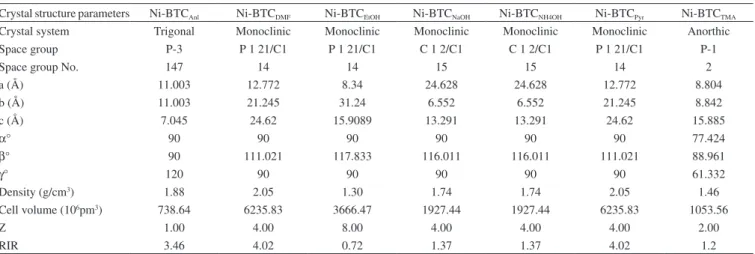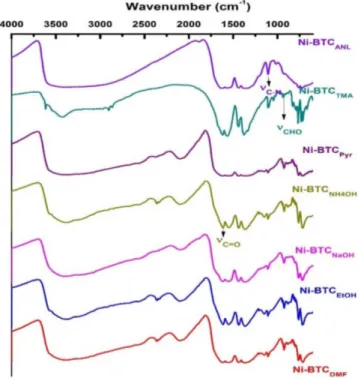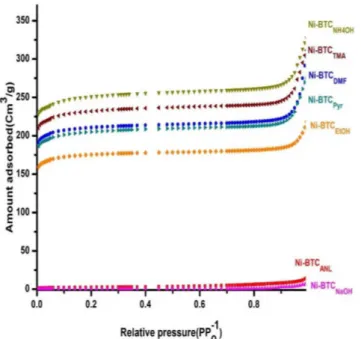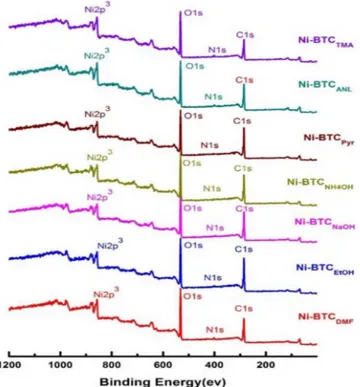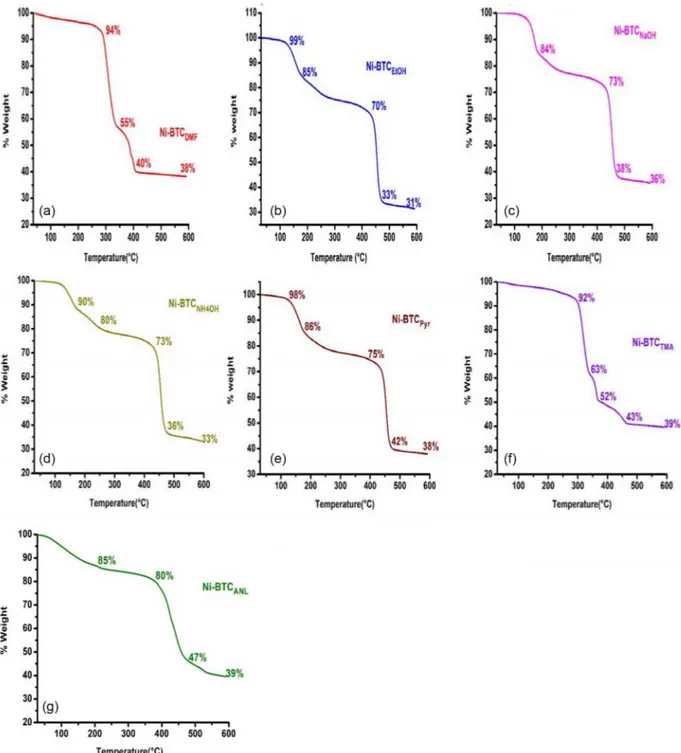Artigo
*e-mail: wgchun@jejunu.ac.kr
SCOPE OF VARIOUS SOLVENTS AND THEIR EFFECTS ON SOLVOTHERMAL SYNTHESIS OF Ni-BTC
Farrukh Israra, Duk Kyung Kimb, Yeongmin Kima and Wongee Chuna,*
aDepartment of Nuclear and Energy Engineering, Jeju National University, Jeju 690-756, Korea bDepartment of Chemistry, Auburn University at Montgomery, Montgomery, AL 36117, USA
Recebido em 12/10/2015; aceito em 16/02/2016; publicado na web em 20/04/2016
Ni-BTC (BTC = 1,3,5-benzene tricarboxylate) metal organic framework (MOF) was synthesized using different solvent conditions. Solvent mixtures of water/N,N-dimethylformamide (DMF), water/ethanol, and water/ethanol/DMF were used for the reactions with or without a variety of bases at 160 °C for 48 hours. Even with same green crystals, prepared MOFs show all different BET surface areas and different XRD patterns. The highest BET surface area of the crystals was 850 m2/g obtained from water/DMF solvent
with NH4OH as a base. The measured surface areas of the crystals follows the order of Ni-BTC(water/DMF-NH4OH) > Ni-BTC(water/DMF-TMA) >
Ni-BTC(water/DMF) > Ni-BTC(water/DMF-Pyridine)> Ni-BTC(water/ethanol)> Ni-BTC(water/DMF-aniline)> Ni-BTC(water/DMF-NaOH).
Keywords: Ni-BTC MOF; different solvent conditions; bases; different BETs.
INTRODUCTION
Coordination polymers and metal organic frameworks (MOFs) represent one of the most attractive research areas of coordination chemistry. The combination of metal ions and organic linkers provides various possibilities for the fabrication of materials with different structure and functionality. These have wide potential applications in the fields of gas adsorption and storage, separation, sensors and catalysis.1-6 These crystalline, highly porous solids can possess ultra--high Brunauer-Emmett-Teller (BET) surface areas (~7000 m2 g-1).7-10 Due to their modular nature and structural tunability, application of MOFs has been widening in the fields of light harvesting,11-15 sensing,16 optical luminescence,17,18 ionic conductivity,19-21 nonlinear optical behavior22 and as precursors for the synthesis of nanomaterials with interesting properties.23-29
A huge variety of MOFs have been synthesized and reported so far with synthesis techniques such as hydrothermal, solvothermal, microwave assisted heating, mechanochemical, electrochemical and, more recently, ultrasonic processes.30 Ni-BTC, as a part of this long chain of MOFs, has been initially reported by Yaghi.31 DUT-932 constructed by btb linkers (btb = benzene 1,3,5-tribenzoate) and {Ni5(µ3-O)2(O2C)6}, porous paddle-wheel structures using different combination of metal/organic linker/base/solvents via high throughput synthesis33 and CPO-27(Ni)34 are few other noticeable contributions to Ni based porous solids.
Because each different lab has been reporting different solvent conditions, solvent effect was tested in this study with different solvent mixtures of water/N,N-dimethylformamide (DMF), water/ ethanol, and water/ethanol/DMF with or without a variety of bases at 160 °C for 48 hours. Because bases added to the solution may help deprotonate from BTC for the formation of Ni-BTC, the effect of a variety of bases of NaOH, NH4OH, pyridine (Pyr), aniline (Anl), and trimethylamine (TMA) was also tested in this research work. In the present work, we have opted for solvothermal synthesis of Ni-BTC. Isolated MOF crystals were analyzed by X-ray diffraction (XRD) measurement, scanning electron microscope (SEM), FTIR, X-ray photoelectron spectroscopy (XPS) techniques together with the BET surface area measurement.
EXPERIMENTAL
All materials including NiNO3.6H2O (99.5%, Alfa Aesar), 1,3,5-benzenetricarboxylic acid (H3BTC)(99%, Alfa Aesar), DMF (99.8%, Alfa Aesar), ethanol (94-96%, Alfa Aesar), NaOH (pellets 98%, Alfa Aesar), NH3 water (1 mol L-1 NH3 in H2O, Daejung chem.), aniline (99.5%, Daejung chem.), trimethylamine (99%, Alfa Aesar), and pyridine (99.5%, Daejung chem.) were used as received. We have synthesized seven Ni-BTC yields from combination of these solvents.
Preparation of Ni-BTC solution
Two solutions of 20 mmol of NiNO3.6H2O dissolved in 40 mL deionized water and 10 mmol of H3BTC dissolved in 40 mL organic solvent were prepared separately. The two solutions were then mi-xed and loaded in a Teflon liner assembly. Prepared organic solvent was each pure DMF, pure ethanol, a mixture of DMF (24 mL) and 0.2 mol L-1 NH4OH in water (16 mL), a mixture of DMF (25 mL) and 0.2 mol L-1 TMA, a mixture of DMF (26 mL) and 0.2 mol L-1 pyridine in water (14 mL), a mixture of DMF (26 mL) and 0.2 mol L-1 aniline in water (14 mL), and a mixture of DMF (27 mL) and 0.2 mol L-1 NaOH in water (13 mL). Measured pH ranges of the prepared solution mixtures were 2 - 2.15.
The Teflon liner assembly consisted of a Teflon crucible with a cover. This Teflon liner was then placed inside a stainless steel enclosure which was completely tightened before placing it inside the convection oven. Such assembly completely blocked the vapo-rization of any solvent from the reaction system. The assembly is shown in Figure 1.
Each of these solution mixtures was heated at 160 °C for 48 hours in a convection oven. The Teflon liner assembly was then cooled to room temperature. MOF crystals were filtered and washed with deionized water (20 mL × 3) and ethanol (20 mL × 3) successively. The obtained MOF crystals were dried for 12 hours at 100 °C prior to the analytical works.
Characterization
The XRD measurement was performed by using Rikagu D/ MAX 2200H (Bede model 200) using a Cu-Kα radiation source of
in 2θ range of 2-60˚ with a step of 0.0092˚. The XRD patterns were analyzed with Xpert HighScore Plus software. The diffraction peaks were identified through search match option with inbuilt ICSD reposi-tory of HighScore Plus software. The Rietveld analysis was used to obtain approximated chemical formulas of product phases in each synthesized MOF. The FTIR spectra were collected on a Bruker IFS66/S Fourier transform IR spectrophotometer for the MOF-KBr disks at room temperature. The scanning electron microscopy (SEM) observations were performed on JEOL, JEM1200EX II set up equipped with field emission gun. BET surface areas of the samples were determined from N2 adsorption isotherms at liquid nitrogen temperature (−196 °C) using a Micrometrics ASAP 2420. Surface composition of MOFs was measured with theta probe AR-XPS system (Thermo Fisher Scientific, UK). XPS measurements were made with mono chromatic Al-Kα X-ray source. Thermogravimetric analyses
were recorded through SDT2960 (DTA-TGA).
RESULTS AND DISCUSSION
Ni-BTC MOF was obtained by solvothermal reaction of NiNO3.6H2O and H3BTC in 2:1 molar ratio as described before. Light green MOFs were obtained from the reactions. The isolated yields of MOFs were variable between 34~75% depending on the applied solvent conditions. The physical properties of isolated Ni-BTC MOFs
are listed in Table 1. The highest yield of 75% was obtained from Ni-BTCNaOH. Solutions with the addition of base improved the isolated yields ranging 73~75%, except for the case of aniline, Ni-BTCAnl, addition (34%). Conditions without base resulted in either similar yield of 72% for BTCEtOH or relatively low yield of 57% for Ni-BTCDMF. A comparison with some selected previously reported syn-thesis routes has been presented in Table 2. It represented a summary of results from various previously synthesized Nickel based MOFs. It gave a good account of variety of synthesis techniques, organic linkers and operational conditions for the preparation of the final product.
The XRD patterns are shown in Figure 2. Interestingly, all of the XRD patterns show different diffraction patterns meaning they are formed with different crystal structures. The XRD patterns from the products in this synthesis are quite different from those reported in various studies,31-34 since each and every process has been accom-plished with variety of solvents, reaction conditions, metal precursors and reaction modes. Thus every aspect of chemical reaction, whether it is the nature of solvent and precursor, base solution, reaction tem-perature, synthesis route and reactant concentration, has a strong bearing on the final structure of the product. This fact appeared quite evidently during this synthesis. Here every Ni-BTC resulting from various combinations of solvents and bases showed a unique XRD pattern, which is a testimony of the fact that each Ni-BTC has nucle-ated with its own crystal structure as shown in Table 1 and from their chemical composition.
In comparison, the XRDs of Ni-BTCs resulting from the combina-tions of water/DMF-NaOH, water/DMF-NH4OH, water/DMF-pyr and water/DMF-TMA showed good crystallinity. The peaks appearing in these patterns are more pronounced and sharp. It seemed that a majority of bases in the present work have helped in deprotonation of carboxylic acid and the resultant Ni-BTCs are more refined. Whereas the addition of aniline seemed to have negative effect which not only reduced the % yield, but also resulted in a product which have distorted structure.
The patterns were analyzed with HighScore Plus. For each XRD pattern, a diffraction line (with *) at 2θ value of 2.80° denotes the Ni2O3 (002) impurity presence. The detailed analysis of XRD patterns and Rietveld analysis revealed the results as under:
Ni-BTCANL:(C17 H19 N2 Ni5 O10); calc: C = 28.9%, H = 2.69%, N = 3.97%, Ni = 41.66%, O = 22.71%.
Ni-BTCDMF: (C39 H44 N4 Ni14 O21); calc: C = 27.12%, H = 2.54%, N = 3.24%, Ni = 47.6%, O = 19.46%.
Ni-BTCEtOH: (C12 H23 N4 Ni O4); calc: C = 41.65%, H = 6.65%, N = 16.2%, Ni = 16.98%, O = 18.51%.
Ni-BTCNaOH: (C4.5 H17.64 N8.7 Ni2.3 O3.8); calc: C = 14%, H = 4.54%, N = 31.25%, Ni = 34.5%, O = 15.7%.
Figure 1. Teflon liner assembly
Table 1. The structural parameters of synthesized MOFs
Crystal structure parameters Ni-BTCAnl Ni-BTCDMF Ni-BTCEtOH Ni-BTCNaOH Ni-BTCNH4OH Ni-BTCPyr Ni-BTCTMA
Crystal system Trigonal Monoclinic Monoclinic Monoclinic Monoclinic Monoclinic Anorthic
Space group P-3 P 1 21/C1 P 1 21/C1 C 1 2/C1 C 1 2/C1 P 1 21/C1 P-1
Space group No. 147 14 14 15 15 14 2
a (Å) 11.003 12.772 8.34 24.628 24.628 12.772 8.804
b (Å) 11.003 21.245 31.24 6.552 6.552 21.245 8.842
c (Å) 7.045 24.62 15.9089 13.291 13.291 24.62 15.885
α° 90 90 90 90 90 90 77.424
β° 90 111.021 117.833 116.011 116.011 111.021 88.961
γ° 120 90 90 90 90 90 61.332
Density (g/cm3) 1.88 2.05 1.30 1.74 1.74 2.05 1.46
Cell volume (106pm3) 738.64 6235.83 3666.47 1927.44 1927.44 6235.83 1053.56
Z 1.00 4.00 8.00 4.00 4.00 4.00 2.00
Ni-BTCNH4OH: (C7 H25 N11 Ni3 O4); calc: C = 17.4%, H = 5.07%, N = 32.68%, Ni = 33.2%, O = 11.65%.
Ni-BTCPyr: (C40 H46 N5 Ni15 O22); calc: C = 26.5%, H = 2.53%, N = 3.55%, Ni = 48.44%, O = 17.34%.
Ni-BTCTMA: (C18 H33 N9 Ni4 O8); calc: C = 29.27%, H = 4.47%, N = 17.07%, Ni = 31.82%, O = 17.34%.
The crystal structure parameters of these MOFs are shown in Table 1. The FTIR spectra of all of the synthesized MOFs are shown in Figure 3. They show similar IR absorption patterns with Ni ion coordinated COO moiety in the range of 1350-1650 cm-1,35 and ν
C-N and νCN-CHO vibrational frequencies observed at 1103 and 936 cm-1
indicated the presence of Ni coordinating to DMF molecules. The C=O band at 1600 cm-1 in FTIR spectra of Ni-BTCs represented the amide group from DMF. In general, the amide group from DMF appears at 1630-1695 cm-1 in IR spectra. From the Figure 3 it is evident that Ni-BTCTMA, Ni-BTCNH
4OH and Ni-BTCNaOH showed more intense Ni-DMF coordination band as compared to the rest of the four Ni-BTCs.
Table 2. Comparison with some selected synthesis routes
MOFs Synthesis Route Reaction Time
(Hours)
Reaction
Temperature (°C) %Yield Reference
Ni-BTCDMF Solvo-thermal 48 160 57 Present work
Ni-BTCNH4OH Solvo-thermal 48 160 73 Present work
Ni-BTCTMA Solvo-thermal 48 160 73 Present work
Ni-BTCPyr Solvo-thermal 48 160 74 Present work
Ni-BTCAnl Solvo-thermal 48 160 34 Present work
Ni-BTCNaOH Solvo-thermal 48 160 75 Present work
Ni-BTCEtOH Solvo-thermal 48 160 72 Present work
Ni3C18H30O24 Hydrothermal 12 170 Not mentioned [31]
DUT-9 Solvo-thermal 20 120 54 [32]
CPO-27(Ni) CE heating Not mentioned 70 Not mentioned [34]
CPO-27(Ni) Microwave heating Not mentioned 70 Not mentioned [34]
CPO-27(Ni) Ultrasonic Not mentioned 70 Not mentioned [34]
[Ni3(BTC)2(Me2NH3].
(DMF)4(H2O)4
High throughput 48 170 35 [33]
[Ni6(BTC)2(HCOO)6.
(DMF)6]
High throughput 48 150 67 [33]
[Ni3(BTB)2(2-MeIm)1.5
(H2O)1.5].(DMF)9(H2O)6.5
High throughput 48 170 78 [33]
[Ni2(BDC)2(DABCO)].
(DMF)4(H2O)4
High throughput/ Microwave heating
2 110 59 [33]
[Ni2(BDC)2(DABCO)].
(DMF)4(H2O)1.5
High throughput 48 110 70 [33]
[Ni2(BDC)2(DABCO)].
(DMF)4(H2O)2
High throughput/ Microwave heating
2 110 53 [33]
Figure 2. XRD patterns of Ni-BTCs
The BET adsorption isothermal experiment was performed with N2 at liquid nitrogen temperature (-197 °C), and the resulted plots are shown in Figure 4. The BET surface area data are summarized in Table 3. The largest BET surface area was obtained from Ni-BTCNH4OH with 850 m2/g. The other MOFs also showed good potential in terms of their physiosorption, and properties such as pore size, pore volume and average particle size, except for MOFs of Ni-BTCAnl and Ni-BTCNaOH, which are basically meso-porous with extremely low BET surface areas of 8.96 and 1.8692 m2 g-1, respectively. Pore volumes are reasonably ranged between 0.36-0.51 cm3 g-1 from good Ni-BTCs MOFs.
The calculated pore diameters of Ni-BTCDMF, Ni-BTCNH 4OH, Ni-BTCTMA, Ni-BTCEtOH and Ni-BTCpyr are in 20-25 Å range, which is higher than the average molecular diameter of N2 (16.2 Å). Thus, these Ni-BTCs present enough surface area and pore window opening to nitrogen gas for adsorption. The addition of bases NH4OH, TMA and pyridine to the solvent mixture of water/DMF tends to produce a Ni-MOF yield with appreciable surface area. Possibly the base ad-dition is helping in the removal of solvent molecules from the pores of synthesized MOF. Surprisingly, NaOH is the stronger base than the rest and its deprotonation effects are evident from the 75% yield of Ni-BTCNaOH. But NaOH did not prove to be effective in obtaining high surface area Ni-MOF, probably due to the pore window size be-ing too much restricted in this case that it did not allow the nitrogen gas molecules to access the pores. Similarly, the addition of aniline is also working negatively. Aniline is a weak base and does not seem to facilitate the formation of MOF either.
The top 5 nm surface compositions of MOFs were measured by XPS analysis and the plots are shown in Figure 5. The XPS results demonstrate the appearance of C1s, Ni2p3 and O1s peaks, which is the
testimony for the presence of fundamental elements of BTC coordi-nated to Ni in this metal organic framework. The surface morphology through scanning electron microscope (SEM) images in Figure 6 (a) of the MOF powders suggested that Ni-BTCAnl has granular structure (a), whereas the other Ni-BTCs (b-g) have predominantly rod shaped particle morphology for each MOF.
Table 3. Isolated yield and physical properties of Ni-BTC MOFs obtained from different organic solvent conditions
MOFs Organic solvent SSABET (m2/g) Pore volume (cm3/g) %Yield XPS Surface
composition
Ni-BTCDMF DMF (40 mL) 710 0.42 57 C1s (52.4%)
N1s (2.88%) Ni2p3 (7.83%)
O1s (36.9%)
Ni-BTCEtOH Ethanol (40 mL) 590 0.36 72 C1s (58.0%)
N1s (1.57%) Ni2p3 (6.66%)
O1s (33.8%)
Ni-BTCNH4OH DMF (24 mL) + 850 0.51 73 C1s (56.5%)
0.2M NH4OH (16 mL) N1s (1.36%)
Ni2p3 (6.65%) O1s (35.4%)
Ni-BTCTMA DMF (25 mL) + 790 0.46 73 C1s (51.44%)
0.2M TMA (15 mL) N1s (2.77%)
Ni2p3 (8.67%) O1s (37.12%)
Ni-BTCPyr DMF (26 mL) + 690 0.41 74 C1s (57.8%)
0.2M Pyr (14 mL) N1s (1.29%)
Ni2p3 (6.23%) O1s (34.73%)
Ni-BTCAnl DMF (26 mL) + 8.9 0.023 34 C1s (56.4%)
0.2M Anl (14 mL) N1s (2.39%)
Ni2p3 (7.99%) O1s (33.22%)
Ni-BTCNaOH DMF (27 mL) + 1.9 0.014 75 C1s (58.0%)
0.2M NaOH (13 mL) N1s (1.45%)
Ni2p3 (7.10%)
Thermogravimetric analyses were performed under N2 atmo-sphere and the results are shown in Figure 7. Each of the thermogram of Ni-BTCs has three distinct regions at different temperature ranges. Initial weight losses until decomposition were attributed to the loss of moisture and solvent molecules trapped in the cavities.32 The MOF structures of Ni-BTCEtOH, Ni-BTCNaOH, Ni-BTCNH4OH, Ni-BTCpyr and Ni-BTCAnl showed almost similar TGA curves. The respective initial weight losses of 30, 27, 27, 25 and 20% in the same sequence are due to the loss of moisture and solvent molecules until 400 °C. As the heating continued, the MOF structures became unstable and col-lapsed. The Ni-BTCDMF showed good thermal stability with a weight loss of 6% up to 300 °C. This weight loss may be due to the moisture content in the MOF. From 300-325 °C, the weight loss increased up to 45%. The increased weight loss may be attributed to the separation of DMF molecules from the structure. Between 325-400 °C MOF network decomposed and finally a residue of 38% was left after the completion of process. In TGA curve of Ni-BTCTMA, the structure was quite stable until 300 °C as the initial loss in weight was just 8%, however, as the heating continued there appeared a rapid and spontaneous decrease of weight due to simultaneous separation of water molecules and DMF solvent. In the process MOF structure collapsed around 350 °C.
In comparison, five BTCs (BTCEtOH, BTCNaOH, Ni-BTCNH4OH, Ni-BTCpyr and Ni-BTCAnl) showed good thermal stability and these structures were proved to be more robust than the other
Figure 5. XPS analysis graphs of Ni-BTCs
Figure 6. Scanning Electron Microscope image of Ni-BTC MOFs. (a) Ni-BTCAnl; (b) Ni-BTCDMF; (c) Ni-BTCEtOH; (d) Ni-BTCNaOH; (e) Ni-BTCNH4OH; (f) Ni-BTCPyr;
Figure 7. Thermo gravimetric results from Ni-BTC MOFs
two. In a way, it can be safely predicted that incorporation of bases tends to produce MOF structures which have comparatively higher chemical and thermal stability.
CONCLUSION
Solvothermal synthesis of Ni-BTC MOF was performed with a variety of solvent conditions with or without addition of bases at 160 °C for 48 hours. Physical properties of MOFs obtained from each reaction condition were tested. BET surface areas are ranged between 590-850 m3 g-1 and pore volumes between 0.36-0.51 cm3 g-1 which show reasonably acceptable potential in terms of their gas physiosorption property, except for the Ni-BTCAnl and Ni-BTCNaOH which show extremely small cavities within MOFs.
Solutions with the addition of base improved the isolated yields
ranging 72~75% except for the case of aniline, Ni-BTCAnl, addition (34%), whereas pure DMF condition (Ni-BTCDMF) resulted in 57% of isolated yield. Addition of NH4OH for the preparation of reaction sample lead to the optimum MOF with the highest BET surface area of 850 m2 g-1, pore volume of 0.51 cm3 g-1 and good isolated yield of 74%. All XRD patterns show all different diffraction patterns from different crystal structures, and the crystal of Ni-BTCAnl with the lowest surface area does not show clear diffraction patterns.
ACKNOWLEDGMENT
REFERENCES
1. Maji, T. K.; Matsuda, R.; Kitagawa, S.; Nat. Mater. 2007, 6, 142.
2. Murray, L. J.; Dinca, M.; Long, J. R.; Chem. Soc. Rev. 2009, 38, 1294. 3. Wang, P.; Okamura, T. A.; Zhou, H. P.; Sun, W. Y.; Tian, Y. P.; Chin.
Chem. Lett. 2013, 24, 20.
4. Chen, S.S.; Chen, M.; Takamizawa, S.; Chem. Commun. 2011, 47, 4902.
5. Seyedi, S. M.; Sandaroos, R.; Zohuri, G. H.; Chin. Chem. Lett. 2010, 21, 1303.
6. Zhao, Y.; Zhou, X.; Okamura, T.; Chen, M.; Lu, Y.; Sun, W.-Y.; Yu, J.-Q.;
Dalton Trans. 2012, 41, 5889.
7. Furukawa, H.; Ko, N.; Go, Y. B.; Aratani, N.; Choi, S. B.; Choi, E.; Yazaydin, A. O.; Snurr, R. Q.; O’Keeffe, M.; Kim, J.; Yaghi, O. M.;
Science 2010, 329, 424.
8. Yuan, D.; Zhao, D.; Sun, D.; Zhou, H. C.; Angew. Chem., Int. Ed. 2010, 49, 5357.
9. Farha, O. K.; Eryazici, I.; Jeong, N. C.; Hauser, B. G.; Wilmer, C. E.; Sarjeant, A. A.; Snurr, R. Q.; Nguyen, S. T.; Yazaydin, A. Ö.; Hupp, J. T.; J. Am. Chem. Soc. 2012, 134, 15016.
10. Farha, O. K.; Yazaydın, A. Ö.; Eryazici, I.; Malliakas, C. D.; Hauser, B. G.; Kanatzidis, M. G.; Nguyen, S. T.; Snurr, R. Q.; Hupp, J. T.; Nat. Chem. 2010, 2, 944.
11. So, M. C.; Jin, S.; Son, H. J.; Wiederrecht, G. P.; Farha, O. K.; Hupp, J. T.; J. Am. Chem. Soc. 2013, 135, 15698.
12. Son, H. J.; Jin, S.; Patwardhan, S.; Wezenberg, S. J.; Jeong, N. C.; So, M.; Wilmer, C. E.; Sarjeant, A. A.; Schatz, G. C.; Snurr, R. Q.; Farha, O. K.; Wiederrecht, G. P.; Hupp, J. T.; J. Am. Chem. Soc. 2013, 135, 862.
13. Jin, S. Y.; Son, H. J.; Farha, O. K.; Wiederrecht, G. P.; Hupp, J. T.; J. Am. Chem. Soc. 2013, 135, 955.
14. Kent, C. A.; Mehl, B. P.; Ma, L.; Papanikolas, J. M.; Meyer, T. J.; Lin, W.; J. Am. Chem. Soc. 2010, 132, 12767.
15. Kent, C. A.; Liu, D.; Ma, L.; Papanikolas, J. M.; Meyer, T. J.; Lin, W.;
J. Am. Chem. Soc. 2011, 133, 12940.
16. Kreno, L. E.; Leong, K.; Farha, O. K.; Allendorf, M.; Van Richard P., D.; Hupp, J. T.; Chem. Rev. (Washington, DC, U. S.) 2012, 112, 1105. 17. Sun, C.-Y.; Wang, X.-L.; Zhang, X.; Qin, C.; Li, P.; Su, Z.-M.; Zhu,
D.-X.; Shan, G.-G.; Shao, K.-Z.; Wu, H.; Li, J.; Nat. Commun. 2013, 4, 2717.
18. Cui, Y.; Yue, Y.; Qian, G.; Chen, B.; Chem. Rev. (Washington, DC, U. S.) 2012, 112, 1126.
19. Aubrey, M. L.; Ameloot, R.; Wiers, B. M.; Long, J. R.; Energy Environ. Sci. 2014, 7, 667.
20. Shigematsu, A.; Yamada, T.; Kitagawa, H.; J. Am. Chem. Soc. 2011, 133, 2034.
21. Horike, S.; Umeyama, D.; Kitagawa, S.; Acc. Chem. Res. 2013, 46, 2376.
22. Lin, W.; Wu, S. In Metal-Organic Frameworks; MacGillivray, L. R., ed.; John Wiley & Sons: Hoboken, 2010; pp 193-213.
23. Pang, H.; Gao, F.; Chen, Q.; Liu, Q.; Dalton Trans. 2012, 41, 5862. 24. Wang, D.; Ni, W.; Pang, H.; Electrochim. Acta 2010, 55, 6830.
25. Shi, H.-Y.; Deng, B.; Zhong, S.-L.; Wang, L.; Xu, A.-W.; J. Mater. Chem. 2011, 21, 12309.
26. Jin, L. N.; Liu, Q.;Sun, W. Y.; CrystEngComm 2012, 14, 7721. 27. Cho, W.; Park, S.; Chem. Commun. 2011, 47, 4138.
28. Jung, S.; Cho, W.; Lee, H. J.; Oh, M.; Angew. Chem. , Int. Ed. 2009, 48, 1459.
29. Masoomi, M. Y.; Morselli. A.; Chem. Rev. 2012, 256, 2921.
30. Lee, Y. R.; Kim, J.; Ahn, W. S.; Korean J. Chem. Eng. 2013, 30, 1667.
31.Yaghi, O. M.; Li, H.; Groy, T. L.; J. Am. Chem. Soc. 1996, 118, 9096. 32. Gedrich, K.; Senkovska, I.; Klein, N.; Stoeck, U.; Henschel, A.; Lohe,
M. R.; Baburin, I. A.; Mueller, U.; Kaskel, S.; Angew. Chem., Int. Ed.
2010, 49, 8489.
33. Maniam, P.; Stock, N.; Inorg. Chem. 2011, 50, 5085. 34. Haque, E.; Jhung, S. H.; Chem. Eng. J. 2011, 173, 866.
35. Kumagai, H.; Oka, Y.; Akita-Tanaka, M.; Inoue, K.; Inorg. Chim. Acta
